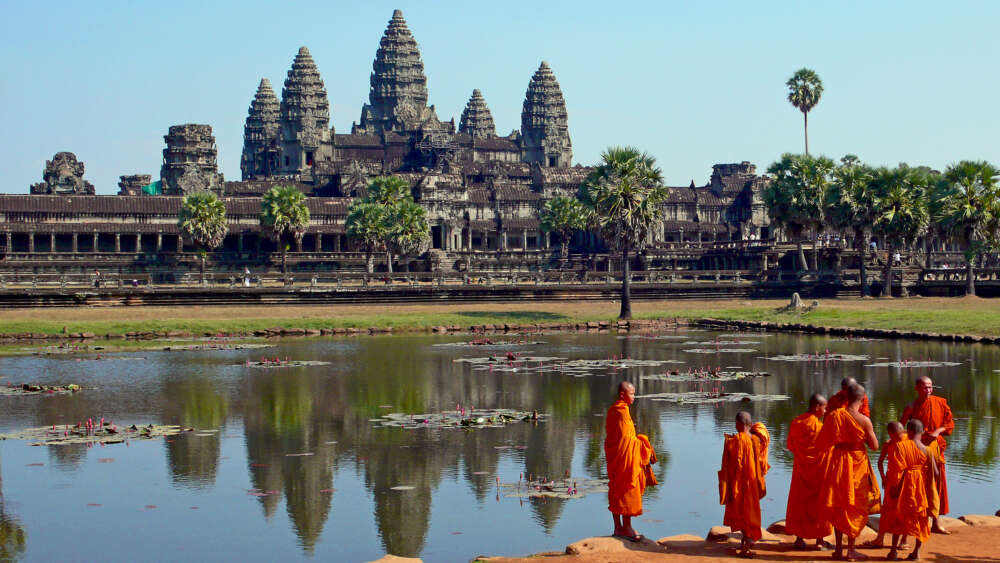The 3D Gospel: how to share Jesus across cultures
The mission field is at our door – be ready
During my formative years, my family lived on Sydney’s leafy North Shore. This was the 1970s and 80s, when that part of Sydney was predominantly an Anglo-Saxon Bible belt, and people would have described themselves as “upper-middle-class”. Most of the families in our street went to the local church at least at Christmas and Easter, and most “kids” were sent to Sunday school while many parents, particularly fathers, stayed home to read the voluminous weekend newspapers.
After Year 9, many of us went on to the “youth fellowship” that gathered on a late Sunday afternoon. We then stayed on for the evening church service, where we would hear sermons that exposed our many sins and were overtly designed to make us feel guilty – to instil change in our young lives – or even to bring about some form of repentance away from our fun-seeking selves to a more sober outlook on life.
I am not being altogether negative about this style of preaching. It was certainly popular, as this church grew from sparsely populated pews in the early 1980s to overflowing in the 1990s. Many people were convicted of their sins and came to a better understanding of themselves and their need for the gospel. They were driven by guilt to tithe (or give generously), share their Christianity with family and friends, come to church regularly, and be actively involved by having their names on a service roster. All these responses were good things to do. This was the church that enthusiastically sent my young family out to the field with the Church Missionary Society to Cambodia in 2001 (along with six other link churches).
There was a growing dissonance between what we had studied in our training and what we experienced in the field.
The year before we departed for the mission field, we spent about five months at a missionary training centre in Melbourne called St Andrew’s Hall, and we regularly attended a Cambodian church at Box Hill. An essential part of our training was to study the culture of our intended field of missionary service. We learned that Cambodians are mostly Buddhists and that their culture was profoundly different to our own. While our cultural outlook was predominantly based on truth and guilt, theirs was based primarily on honour and shame. Ours was an individualist culture that prided itself on self-sufficiency and the search for foundational truths. Theirs was based upon the family unit, saving face (avoiding shame) and avoiding visible outbursts of anger. These were useful lessons for a missionary sent to Asia as a teacher of the Bible and theology.

Dave teaching at Phnom Penh Bible School
When we finally arrived at our destination, we soon began immersion into the local language and culture. However, there was a growing dissonance between what we had studied in our training and what we experienced in the field. We lived in the city of Phnom Penh, while most of the locals we interacted with daily originated from the rural areas of Cambodia. This is understandable, as the city was tragically depopulated during the Khmer Rouge era (1975-79).
These people did not grow up in a shame and honour culture but came from one predominantly based on fear and power.
On the days of religious festivals, the locals would go to make offerings at the many Buddhist temples located at regular intervals throughout the city or they would return to their home village in the countryside to take part in family festivities and religious practices at the local wat. However, many would also have household shrines where they would seek to appease their ancestral spirits. They would go to Buddhist monks to receive amulets that protected against malevolent spirits. When they got sick, they would at first use the “Cambodian medicine” provided by local healers which, to our eyes, appeared to be based on superstition. Only if the malady lingered would they would resort to Western medicine. What was going on here?
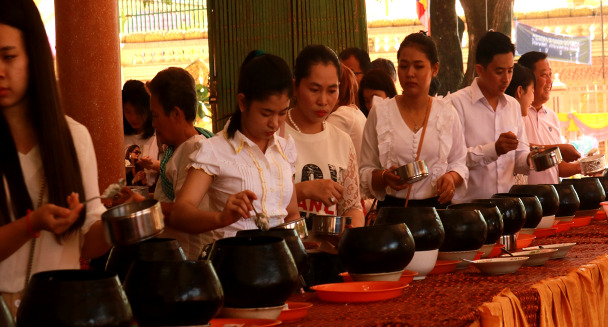
Cambodian Buddhists feeding the spirits of the dead at a local wat during the festival of Pcheum Benh
On reflection, after two decades in-country, I realised these people did not grow up in a shame and honour culture but came from one predominantly based on fear and power. They feared the presence of an invasive spirit world and sought power to protect themselves from its afflictions. They wanted to avoid the misfortune brought about by curses and bad luck, and they pursued dreams and divination for guidance in everyday life. Occasionally, they would dream of a number and use this knowledge to buy a charmed lottery ticket.
The largest national religious holiday – Pcheum Ben – brings the obligation to visit local temples to feed the spirits of the familial dead so they will not be abandoned to roam the land and haunt living relatives. During the pandemic, some rural villagers would place scarecrows, commonly known as Ting Mong, outside their gates to ward off the malevolent spirits of COVID-19.
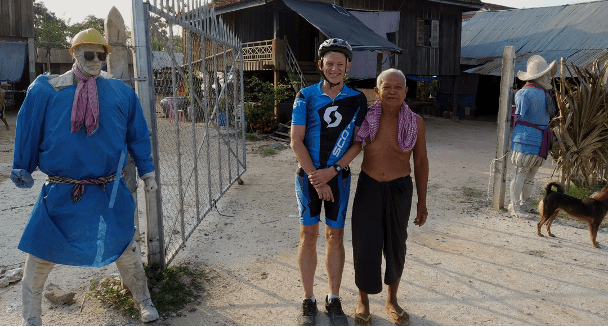
Dave and a new Cambodian friend next to scarecrows designed to ward off the spirits of COVID-19.
Our largest window into this culture is the interaction with our students in the classroom. Our classes are mainly university students and graduates who come to add to their store of “Bible knowledge”. At first, they dare not ask questions in class for fear of shaming the teacher (who may not readily know the answer). When they receive their marks, grades and awards, their nervous anticipation fits the shame-honour paradigm. We avoid creating unnecessary shame by ensuring that at the end of each subject, all our students receive an award, even if only a certificate for patchy attendance. However, their sometimes penetrating theological questions reveal a markedly different worldview. Their fields of particular interest include the body, soul and spirit, miracles (of power) and eschatology (especially the state of the dead). At the same time, if I wrongly add up the marks for an assessment, they are quick to demand justice.
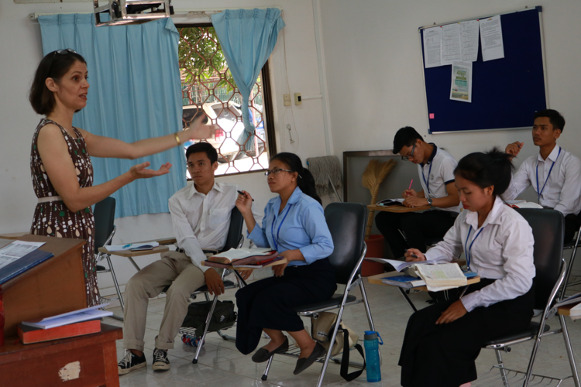
Leoni teaching a class at Phnom Penh Bible School
Recently, I came across a book that greatly assisted me in making sense of this kaleidoscope of worldviews that we have encountered, particularly concerning the gospel. It is appropriately titled: The 3D Gospel: Ministry in Guilt, Shame and Fear Cultures by Jayson Georges.
In summary, Georges portrays three distinct perspectives on the gospel. He shows that all three perspectives are readily portrayed and addressed in the New Testament. Moreover, a mature understanding of the gospel requires comprehension of these three perspectives:
Three different gospel perspectives
Georges perceives that his average Western reader has a perspective that may be summarised as one that chooses to “‘seek justice,’ ‘demand justice,’ and require that ‘justice be served’.” (18) An example of this is the recent reaction to instances of perceived racism in the US. Crowds readily rioted because they perceived injustice and they demanded a concrete response to the situation. Furthermore, our “identity is based upon jobs and hobbies, instead of family or ethnicity.” (19) When people ask us, “What are you?” I know to answer “a missionary” or “a teacher”, depending upon the context and my desired response. Hence, it is hard to escape the shame of being unemployed in the West when seemingly every new conversation begins with this awkward question.
“Each cultural worldview is a unique blend of guilt, shame, and fear.”
However, “human complexities defy simple, either-or categories.” (15) While we want to categorise the people around us neatly, life is rarely that simple. When we first arrived in Phnom Penh, many Cambodians lived in survival mode. They did whatever work they could find to get enough eat. Some rode rickshaws, others gathered recycling along the street, while some picked over the mountain of garbage growing on the city outskirts. Most of these people would have more readily identified with their family or their home village than with their means of daily survival.
“Each cultural worldview is a unique blend of guilt, shame, and fear.” (16) For example, many of my Khmer male friends are now into cycling in a big way. They have become passionate about their new hobby, buying the best bikes and gear available, and they now identify themselves by their new hobby: they are proud “cyclists”. Consequently, they have not completely let go of their group identity, rather, their identity has morphed to include the activities of this new group. The identity of the group is very important. It has a name and of course, a team jersey. Most days, messages will be exchanged in the group chat where we share jokes, cycling tips and plan our next trip.
They are equally competitive as my Western cycling buddies, yet they are more careful to ensure they uphold the values and fellowship of “the group” at every opportunity. This became obvious on one of our rides up Bokor Mountain (about 1000 metres high riding up from near sea level). One of the older Cambodian riders failed to make it to the top (unlike this old foreigner) and then felt he could not face riding down, so he decided to return on the bus. To my surprise, all the other Cambodians “became weary” and decided to join him, and so they missed out on the best part of the ride (the next trip they all rode down).

Dave and the rest of the cycling group at the top of Bokor Mountain after a 1000-metre climb
The three perspectives in the New Testament
In the Gospels, Jesus is shown to be a miracle worker who restores dignity and provides honour to “many who lived in shame due to circumstances beyond their control. The blind, deaf, lame, lepers, bleeding women, demon-possessed, and Gentiles were unclean outcasts whom Jesus restored physically and socially.” (23) In Acts 26:17-18, Paul describes his mission to the Gentiles in three-dimensional terms: “I am sending you to them to open their eyes and turn them from darkness to light, and from the power of Satan to God [power], so that they might receive the forgiveness of sins [innocence] and a place among those who are sanctified by faith in Jesus [honour].”
Paul’s preaching presented a three-dimensional gospel.
Paul’s preaching presented a three-dimensional gospel. “These three strands of the gospel never function in isolation, but the driving forces of a particular culture may warrant an emphasis on one approach above others.” (60-61) He presented the truth of the gospel of forgiveness of sins through Jesus to the Sabbath gathering in Antioch of Pisidia (Acts 13:13–42). He challenged the “men of Israel” and “God-fearing Gentiles” present at the synagogue to understand these historical and propositional truths and receive “the forgiveness of sins” so they might be restored into fellowship with God. The highlights of Paul’s ensuing sermon are God’s miraculous “mighty power” to free his people from Egypt (v18) and raising Jesus “from the dead” (v 30) so that his body “did not see decay” (v 37).
A mature gospel understanding
In 1971 my family got our first television set. It was a black-and-white, cathode-ray tube-filled box that had been passed on from relatives going overseas. The TV was placed on the dining room sideboard and came with an internal aerial attached by a wire that we would take around the room to find the point of best reception. Watching these fuzzy pictures, my brother and I thought we were in heaven. No longer would we have to sneak into friends’ houses to get our fix of afternoon “telly”.
New Christians possess the excitement of my brother and me watching our first television set. They are captivated by a one-dimensional gospel presentation. There is a single aspect of the gospel that, through the work of the Holy Spirit, has taken hold of their imagination and filtered into their thoughts and understanding. They may have rejected the old self and enlarged their worldview to include Christ’s lordship. Maybe, they have become aware of their sin and guilt and the reconciliation on offer through Christ’s atoning death. Perhaps, they have failed in their duty just like the Philippian jailer. Maybe, like Zacchaeus or Bartimaeus, they or their family has a shameful past requiring restoration to a place of honour. Even conceivably, someone lives in fear of the spirit world, or they are even so physically afflicted that they never experience peace or comfort in their lives until a healing miracle is wrought by God’s miraculous power (such as the demoniac or the fortune-telling slave girl in Philippi). Each scenario portrays someone coming to saving faith through an aspect of God’s saving work.
I need to be regularly reminded that “the Bible is one narrative in which forgiveness, honour, and power are woven together.”
As a cross-cultural missionary, I need to be able to reach across the cultural divide to engage with thoughts and experiences alien to my own. I need to see the gospel message from a different perspective. “The tripartite classification of guilt, shame, and fear helps us better understand the world as a whole. The three culture types correspond to other global realities.” (32) I need to be regularly reminded that “the Bible is one narrative in which forgiveness, honour, and power are woven together.” (35)
Furthermore, as our Australian neighbourhoods become increasingly multicultural (the latest census shows that 48.2 per cent of Australians have a parent born overseas and the largest increase in country of birth is India) and “Anglo” culture becomes increasingly removed from its Christian and Enlightenment roots, we need a gospel understanding that can engage with this emerging, and increasingly pagan, society. We need a gospel understanding that can equip us to understand the cultural divide before us, challenge the false presumptions around us, and offer sure hope to those in front of us, a hope that is only found in the lordship of Christ. We need to comprehend the gospel in full Technicolor, on a giant curved screen with ultra-high definition and quantum dot technology, immersed in surround sound, as you might have experienced in a wealthy friend’s home cinema. This is the gospel comprehended in its various cross-cultural contexts. After experiencing this, you would never willingly go back to the old black-and-white telly.
We need to comprehend the gospel in full Technicolor, on a giant curved screen.
Finally, Georges warns us of the consequences of continuing to hold on to a one-dimensional gospel that threatens the veracity and integrity of the Bible. To do so would be to misread Scripture and construct a sub-biblical view of God. If God does not save us from shame and fear (not just theoretically but practically), then we severely minimise his glory as God. “A 3D gospel allows us to more fully worship our holy, glorious, and sovereign God in all of life.” (74)
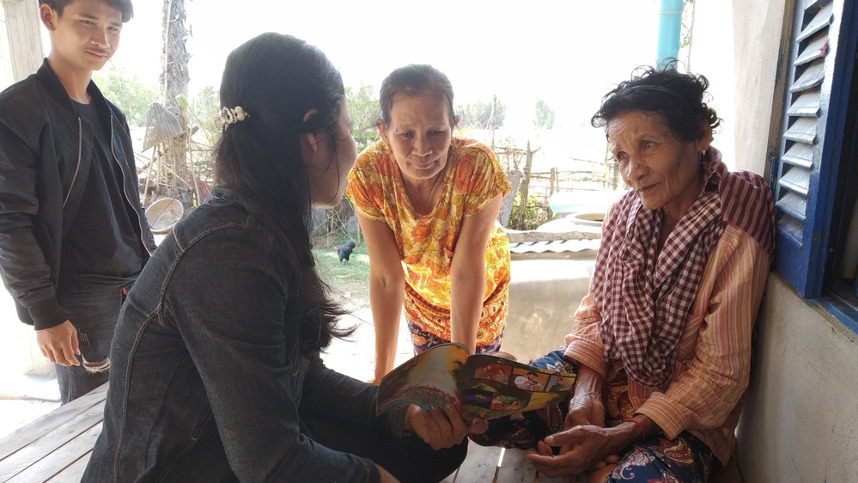
A villager receives the gospel message during a Bible School field trip
The recent Australian census could be seen as a coroner’s report card on a church in its death throes. The sinking membership curves seemingly point to oblivion. Alternatively, it could be a beacon of hope – that the many newer Australians are the mission field coming to us – a ready opportunity for us to present the gospel to them on their terms so that they might be steered away from the rocks of materialism, saved from the clutches of nihilism with its subsequent despair, to make peace with God on his terms, and so gain true and permanent citizenship in the Kingdom of God.
Dave and Leoni Painter are CMS missionaries in Cambodia.
Email This Story
Why not send this to a friend?
